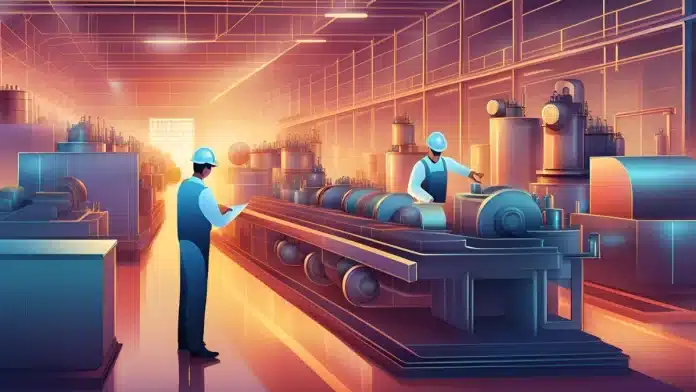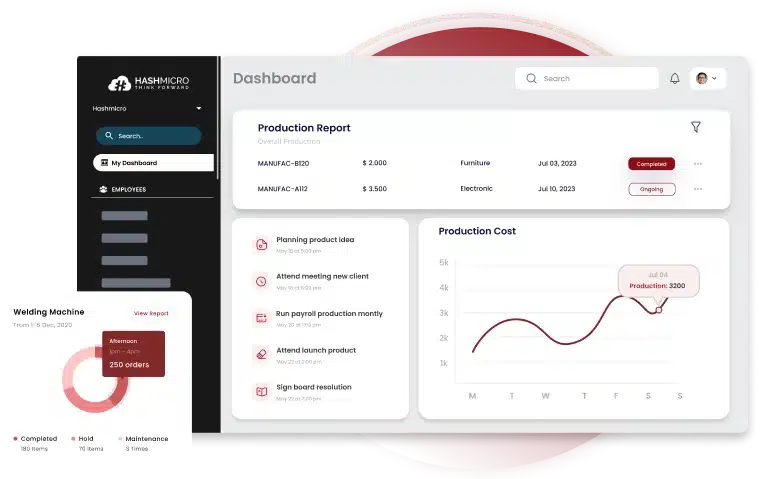Asset management in manufacturing is the process of managing all physical assets to ensure they operate at their best throughout their lifecycle. By implementing effective asset management strategies, companies can monitor, maintain, and optimize the use of each asset.
The company uses asset management to manage all assets it owns. In general, companies that use manufacturing asset management are large-scale companies.
This article will discuss the key benefits of using the asset management manufacturing industry.

Table of Contents
What is Manufacturing Asset Management?
Asset management is a planning and control process related to procurement, operations, maintenance, renewal and disposal of company assets. This process aims to maximize asset utilization and reduce associated costs and risks. This process can help companies manage their assets.
If this is applied to the manufacturing industry, then this process is referred to as Manufacturing Asset Management (MAM). Manufacturing Asset Management (MAM) is the process of managing physical assets used in the manufacturing industry, including equipment, machinery, and other infrastructure.
MAM’s main objective is to ensure that these assets are used optimally throughout their life cycle, from procurement to maintenance, refurbishment and write-off.
The MAM system focuses on the company’s physical assets, but this process has an impact on other resources such as finance, information, and even human resources. Asset management that is integrated with other assets will produce maximum output.
In manufacturing and heavy equipment companies, asset management often includes asset maintenance. Here, asset managers work with maintenance teams who are responsible for carrying out maintenance, as well as other tasks.
Maintenance focuses on handling damage quickly and with minimal disruption, while asset management aims to reduce the level of damage, extend the service life of assets, speed up operational processes, and increase efficiency throughout the factory.
Common Challenges in Managing Manufacturing Assets
Companies that do not use manufacturing management software will face problems. Here are the 3 main problems which can be seen below:
1. Unplanned downtime
Unexpected equipment failures can lead to costly production halts. Without proper preventive maintenance and real-time monitoring, manufacturers often face unplanned downtime, which disrupts operations and impacts profitability.
2. High maintenance costs
Balancing between preventive and reactive maintenance can be challenging. Inefficient maintenance practices, such as waiting for equipment to fail before repairing, result in increased costs, excessive downtime, and shortened asset lifespan.
3. Aging equipment
As assets age, they become less reliable and more prone to failure. Managing the replacement or refurbishment of outdated machinery while maintaining production efficiency is a significant challenge, especially when capital investment is limited.
Best Practices for Effective Manufacturing Asset Management
Of course, there are things we can do to overcome challenges. 3 best practices for effective manufacturing asset management which can be seen below:
1. Implement predictive maintenance
To combat unplanned downtime, manufacturers should adopt predictive maintenance practices. By utilizing IoT sensors and advanced analytics, manufacturers can monitor equipment health in real time and predict potential failures before they occur. This proactive approach minimizes unexpected breakdowns and keeps production running smoothly.
2. Establish a comprehensive maintenance strategy
To reduce high maintenance costs, create a balanced maintenance strategy that combines preventive and predictive maintenance. Regularly scheduled maintenance ensures that equipment is serviced before failures occur, while predictive maintenance identifies specific components that may need attention based on performance data. This strategy optimizes resource allocation and minimizes costly emergency repairs.
3. Invest in equipment upgrades and lifecycle management
To address the challenges posed by aging equipment, manufacturers should develop a robust asset lifecycle management plan. This includes regularly evaluating the performance and reliability of existing equipment, planning for timely upgrades, and making informed decisions on equipment replacements. Investing in modern, efficient machinery enhances productivity and reduces long-term maintenance costs.
Implementing manufacturing inventory management can also help establish effective asset management.
How Software Asset Management Increases Manufacturing Efficiency
1. Optimizing equipment utilization
Effective asset management to optimize asset utilization in manufacturing. This is because manufacturing asset management can analyze and monitor all the performance of the assets owned, increasing the efficiency of existing assets.
2. Reduced downtime
Implementing this management is preventive and predictive, making it easier for companies to predict which assets need to be replaced or repaired periodically. This aims to maintain production continuity and increase operational efficiency in the manufacturing industry.
3. Cost saving
With asset management, goods maintenance strategies will be better. If an item is starting to become unstable, the company can immediately repair it. This can reduce company costs because repairing is more affordable than replacing it with a new one.
4. Improve quality control
The quality of all assets managed will be monitored. To produce quality products, the assets used must also have optimal capabilities. Optimizing assets will increase high-quality products.
5. Facilitate strategic decision making
With comprehensive data on asset performance, utilization, and overall equipment effectiveness (OEE), companies can make better decisions to help them stay competitive in an increasingly tight market by providing input into Monitor key performance indicators (KPIs) to identify trends.
Definition of Factory Asset Management and The Key Component
Factory asset management is a strategic approach to overseeing and optimizing the lifecycle of assets within a manufacturing facility. This discipline encompasses the planning, acquisition, operation, maintenance, and disposal of physical assets such as machinery, equipment, and tools.
Key Components of Factory Asset Management
1. Asset tracking and inventory management
Effective asset management begins with accurate tracking of all assets within the factory. This includes maintaining an up-to-date inventory that records the location, condition, and usage of each asset. Technologies such as barcoding and RFID (Radio Frequency Identification) can facilitate real-time tracking.
2. Maintenance management
Regular maintenance is crucial for ensuring the longevity and performance of factory assets. Implementing a maintenance management system (MMS) helps schedule preventive maintenance, track repairs, and manage maintenance costs. Using data analytics to forecast equipment failures, predictive maintenance strategies can further enhance reliability.
3. Performance monitoring
Continuous monitoring of asset performance is essential for identifying inefficiencies and areas for improvement. Key performance indicators (KPIs) such as uptime, throughput, and energy consumption provide insights into how well assets are performing against set benchmarks.
4. Lifecycle management
Managing the entire lifecycle of an asset—from acquisition to disposal—ensures that resources are utilized effectively. This includes evaluating the total cost of ownership (TCO), making informed decisions about upgrades or replacements, and planning for end-of-life disposal in an environmentally responsible manner.
Optimize Your Manufacturing Asset Management with HashMicro: The Right Solution for Efficiency and Savings!
All manufacturing activities that use asset management that has been integrated with other modules will produce more comprehensive data. Not only that, manufacturing software also increases operational efficiency and productivity by managing production workflows, reducing errors and minimizing costs.
Manufacturing execution systems enable real-time monitoring and analysis of production, support strategic decisions, and strengthen the business’s position in competition. These systems—manufacturing accounting software— include resource planning, supply chain management, quality control, preventive maintenance, and production analysis.
There are currently only a few companies providing manufacturing asset management systems in the Philippines. HashMicro provides this system which has been integrated in accordance with existing regulations.
There are many benefits of manufacturing software that can be obtained through the HashMicro system. The following is an explanation of the function of HashMicro’s manufacturing software:
- Real-time data collection with Kiosk mode
Kiosk mode makes it easier to input data directly from the production floor, speeding up data-based decision making and reducing the risk of manual input errors.
- Tracking costs for materials, labor, subcontractors, and overhead
With comprehensive cost tracking, companies can monitor production costs in more detail, including raw materials, labor, subcontractor costs, and overhead.
- Planning and monitoring the production process
Monitoring the production process helps companies identify problems or delays quickly so they can take corrective action immediately.
- Manufacturing process scheduling
Effective scheduling also helps companies avoid production bottlenecks, so that product delivery to consumers is more timely.
- Predict consumer trends and demands
Companies adjust production capacity to meet market needs, avoid stock shortages, and reduce excess production which risks increasing carrying costs.

Conclusion
Effective asset management is crucial for manufacturing businesses striving to optimize operations, reduce costs, and enhance overall productivity. By implementing robust asset management strategies, companies can significantly extend the lifespan of their equipment, minimize unplanned downtime, and uphold high product quality.
In an increasingly competitive landscape, integrating technology and data-driven decision-making into asset management allows manufacturers to anticipate maintenance needs and swiftly adapt to market demands. This proactive approach not only maximizes the return on asset investments but also fosters a more streamlined and cost-efficient operation.
For those looking to elevate their asset management practices, HashMicro offers comprehensive manufacturing ERP solutions tailored to meet your needs. Experience the benefits of optimized asset management by click the free demo down below.
















































